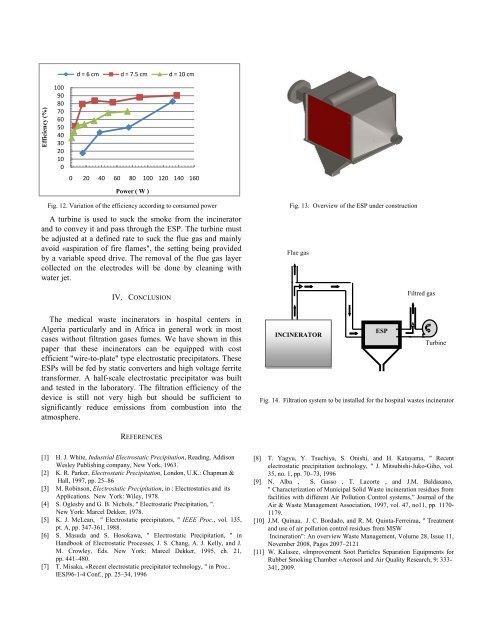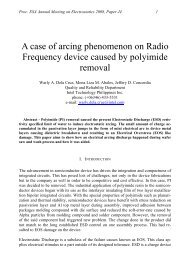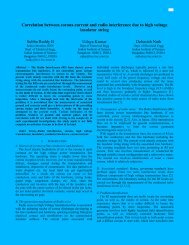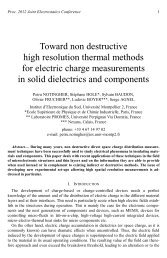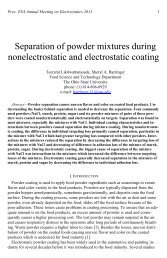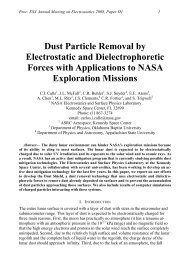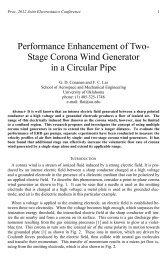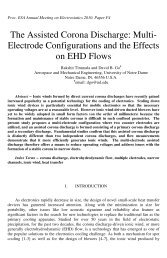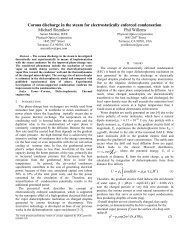Optimization of a Cost-Effective âWire-Plateâ Type ESP for ...
Optimization of a Cost-Effective âWire-Plateâ Type ESP for ...
Optimization of a Cost-Effective âWire-Plateâ Type ESP for ...
Create successful ePaper yourself
Turn your PDF publications into a flip-book with our unique Google optimized e-Paper software.
Efficiency (%)<br />
100<br />
90<br />
80<br />
70<br />
60<br />
50<br />
40<br />
30<br />
20<br />
10<br />
0<br />
d = 6 cm d = 7.5 cm d = 10 cm<br />
0 20 40 60 80 100 120 140 160<br />
Power ( W )<br />
Fig. 12. Variation <strong>of</strong> the efficiency according to consumed power<br />
A turbine is used to suck the smoke from the incinerator<br />
and to convey it and pass through the <strong>ESP</strong>. The turbine must<br />
be adjusted at a defined rate to suck the flue gas and mainly<br />
avoid «aspiration <strong>of</strong> fire flames", the setting being provided<br />
by a variable speed drive. The removal <strong>of</strong> the flue gas layer<br />
collected on the electrodes will be done by cleaning with<br />
water jet.<br />
IV. CONCLUSION<br />
Fig. 13. Overview <strong>of</strong> the <strong>ESP</strong> under construction<br />
Flue gas<br />
Filtred gas<br />
The medical waste incinerators in hospital centers in<br />
Algeria particularly and in Africa in general work in most<br />
cases without filtration gases fumes. We have shown in this<br />
paper that these incinerators can be equipped with cost<br />
efficient "wire-to-plate" type electrostatic precipitators. These<br />
<strong>ESP</strong>s will be fed by static converters and high voltage ferrite<br />
trans<strong>for</strong>mer. A half-scale electrostatic precipitator was built<br />
and tested in the laboratory. The filtration efficiency <strong>of</strong> the<br />
device is still not very high but should be sufficient to<br />
significantly reduce emissions from combustion into the<br />
atmosphere.<br />
<strong>ESP</strong><br />
INCINERATOR<br />
Turbine<br />
Fig. 14. Filtration system to be installed <strong>for</strong> the hospital wastes incinerator<br />
REFERENCES<br />
[1] H. J. White, Industrial Electrostatic Precipitation, Reading, Addison<br />
Wesley Publishing company, New York, 1963.<br />
[2] K. R. Parker, Electrostatic Precipitation, London, U.K.: Chapman &<br />
Hall, 1997, pp. 25–86<br />
[3] M. Robinson, Electrostatic Precipitation, in : Electrostatics and its<br />
Applications. New York: Wiley, 1978.<br />
[4] S. Oglesby and G. B. Nichols, " Electrostatic Precipitation, ".<br />
New York: Marcel Dekker, 1978.<br />
[5] K. J. McLean, " Electrostatic precipitators, " IEEE Proc., vol. 135,<br />
pt. A, pp. 347-361, 1988.<br />
[6] S. Masuda and S. Hosokawa, " Electrostatic Precipitation, " in<br />
Handbook <strong>of</strong> Electrostatic Processes, J. S. Chang, A. J. Kelly, and J.<br />
M. Crowley, Eds. New York: Marcel Dekker, 1995, ch. 21,<br />
pp. 441–480.<br />
[7] T. Misaka, «Recent electrostatic precipitator technology, " in Proc..<br />
IESJ96-1-4 Conf., pp. 25–34, 1996<br />
[8] T. Yagyu, Y. Tsuchiya, S. Onishi, and H. Katayama, " Recent<br />
electrostatic precipitation technology, " J. Mitsubishi-Juko-Giho, vol.<br />
35, no. 1, pp. 70–73, 1996<br />
[9] N. Alba , S. Gasso , T. Lacorte , and J.M. Baldasano,<br />
" Characterization <strong>of</strong> Municipal Solid Waste incineration residues from<br />
facilities with different Air Pollution Control systems,” Journal <strong>of</strong> the<br />
Air & Waste Management Association, 1997, vol. 47, no11, pp. 1170-<br />
1179.<br />
[10] J.M. Quinaa, J. C. Bordado, and R. M. Quinta-Ferreiraa, " Treatment<br />
and use <strong>of</strong> air pollution control residues from MSW<br />
Incineration": An overview Waste Management, Volume 28, Issue 11,<br />
November 2008, Pages 2097–2121<br />
[11] W. Kalasee, «Improvement Soot Particles Separation Equipments <strong>for</strong><br />
Rubber Smoking Chamber «Aerosol and Air Quality Research, 9: 333-<br />
341, 2009.


